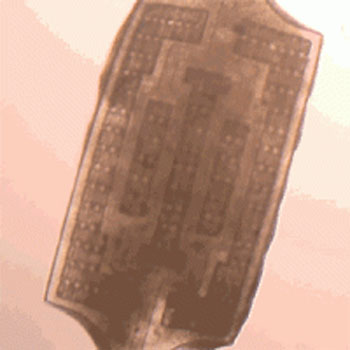Biomedical Engineers Reveal Organ-on-Chip Device for Drug Testing and Organ Repair
By LabMedica International staff writers
Posted on 21 Mar 2016
A soft, biodegradable polymer was used to form a three-dimensional organ-on-chip device for growth of artificial organs that could be used for drug testing or the repair or replacement of damaged organs.Posted on 21 Mar 2016
Poly(octamethylene maleate (anhydride) citrate) (POMaC) is a soft, biodegradable elastomer with the potential to be a good biomaterial for use in scaffolds for soft tissue engineering. POMaC is notable for its dual cross-linking mechanism that allows the engineer to manipulate the resultant mechanical properties of the material during preparation.

Image: When seeded with heart cells, the flexible polymer scaffold contracts with a regular rhythm, just like real heart tissue (Photo courtesy of Boyang Zhang, University of Toronto).
Investigators at the University of Toronto (Canada) used POMaC to fashion "AngioChip" scaffolds comprising a series of thin layers about 50 to 100 micrometers wide, stamped with a pattern of nanopore and micro-hole channels. The layers, which resembled computer microchips, were then stacked into a three-dimensional structure of synthetic blood vessels. The scaffold was bathed in media containing living cells. The cells rapidly attached to the inside and outside of the channels and began growing.
The investigators reported in the March 7, 2016, online edition of the journal Nature Materials that incorporation of nanopores and micro-holes in the vessel walls enhanced permeability, and permitted intercellular crosstalk and extravasation of monocytes and endothelial cells on biomolecular stimulation. They also showed that vascularized hepatic tissues and cardiac tissues engineered by using AngioChips processed clinically relevant drugs delivered through the vasculature, and that millimeter-thick cardiac tissues could be engineered in a scalable manner. Furthermore, AngioChip cardiac tissues implanted into the femoral vessels of rat hindlimbs established immediate blood perfusion.
"It is a fully three-dimensional structure complete with internal blood vessels," said senior author Dr. Milica Radisic, professor of biomedical engineering at the University of Toronto. "It behaves just like vasculature, and around it there is a lattice for other cells to attach and grow. Previously, people could only do this using devices that squish the cells between sheets of silicone and glass. You needed several pumps and vacuum lines to run just one chip. Our system runs in a normal cell culture dish, and there are no pumps; we use pressure heads to perfuse media through the vasculature. The wells are open, so you can easily access the tissue. Our liver actually produced urea and metabolized drugs."
Related Links:
University of Toronto














